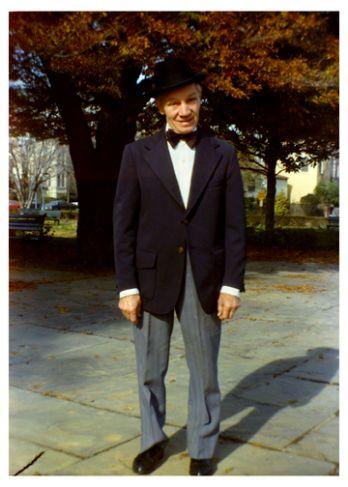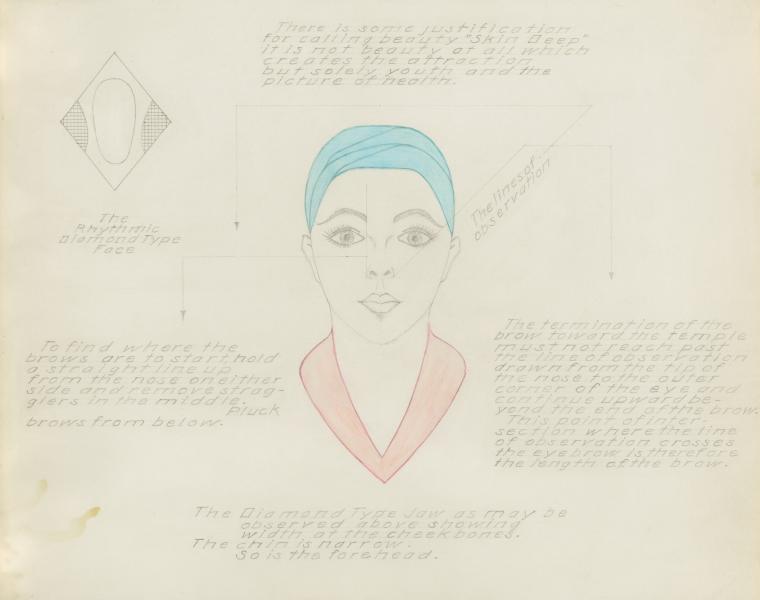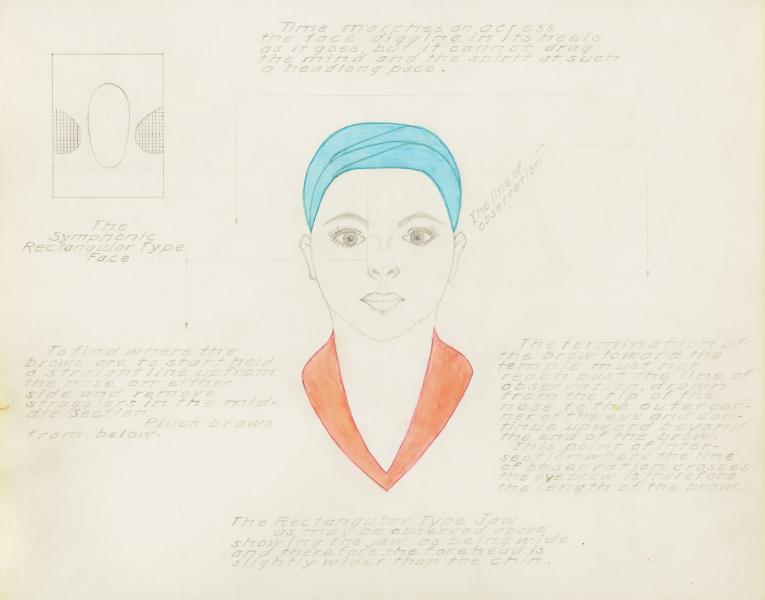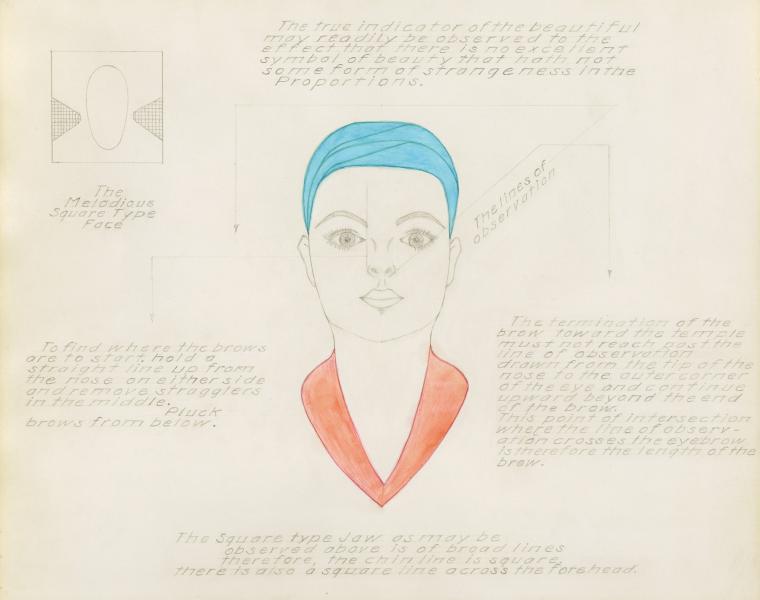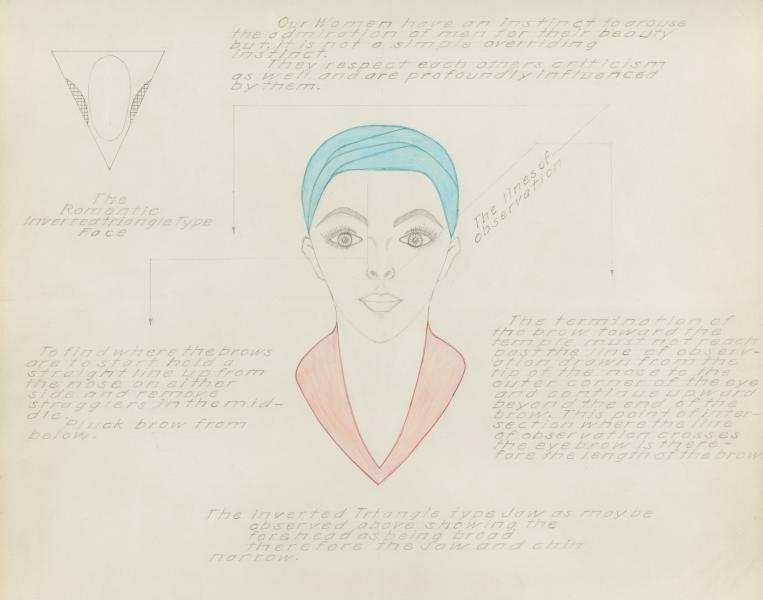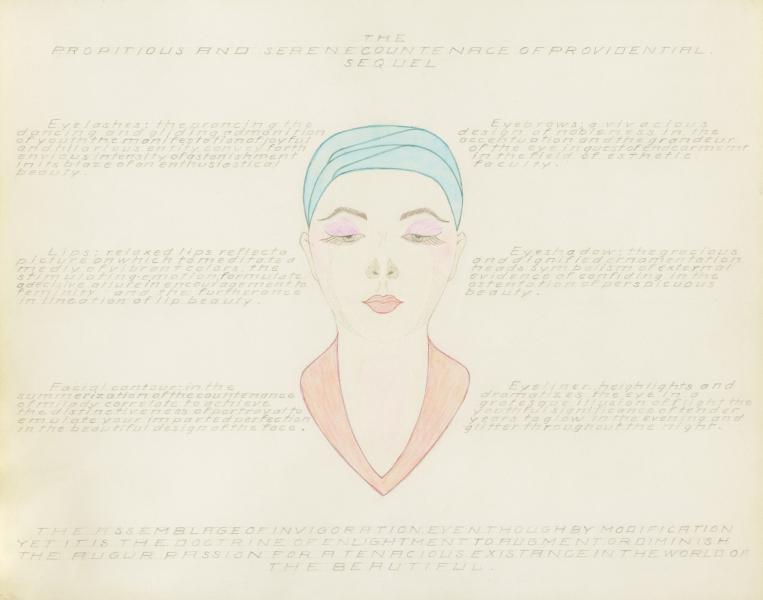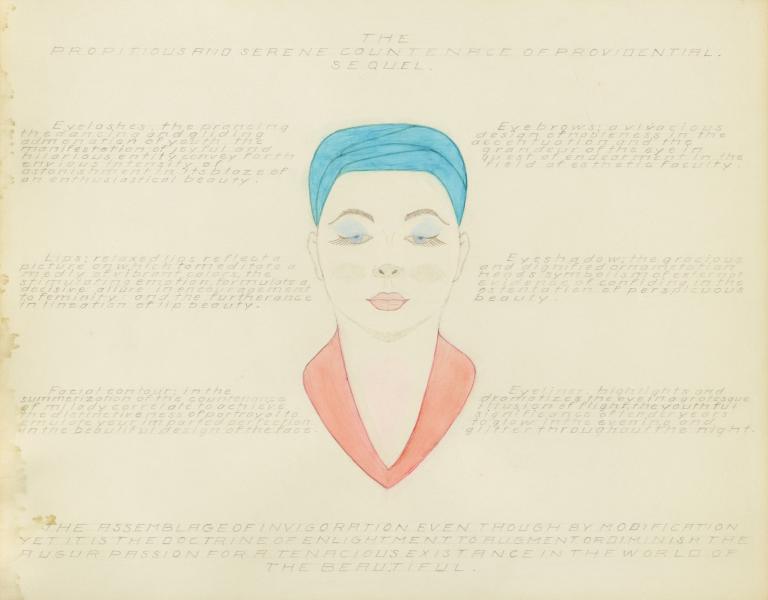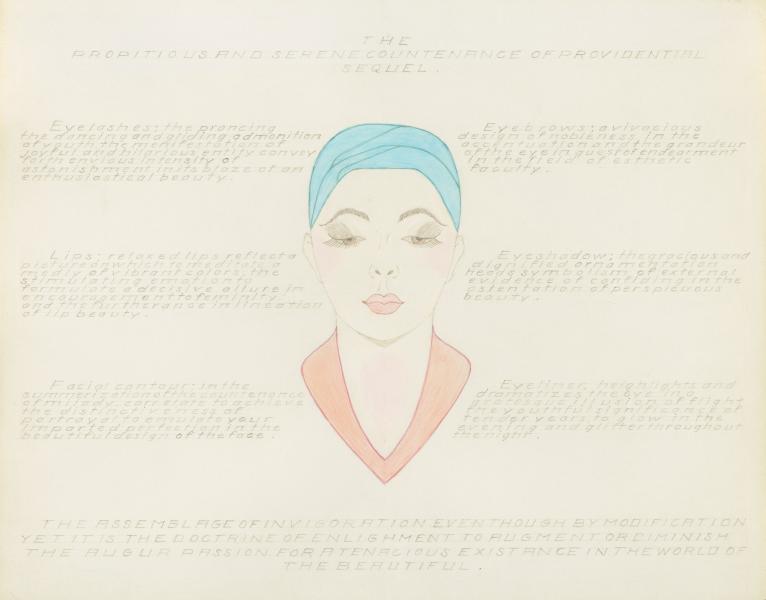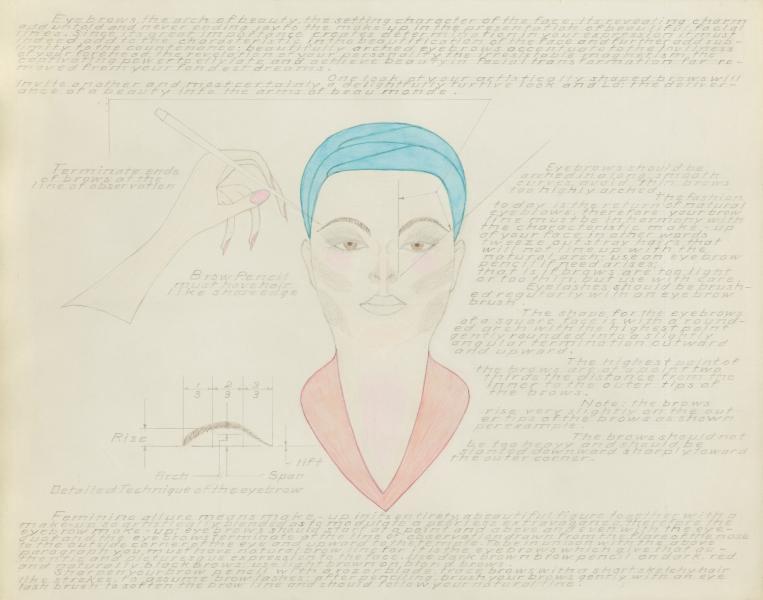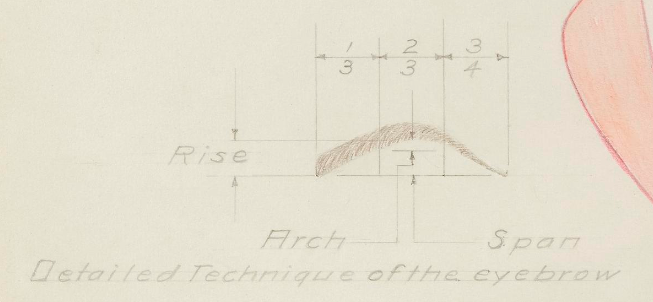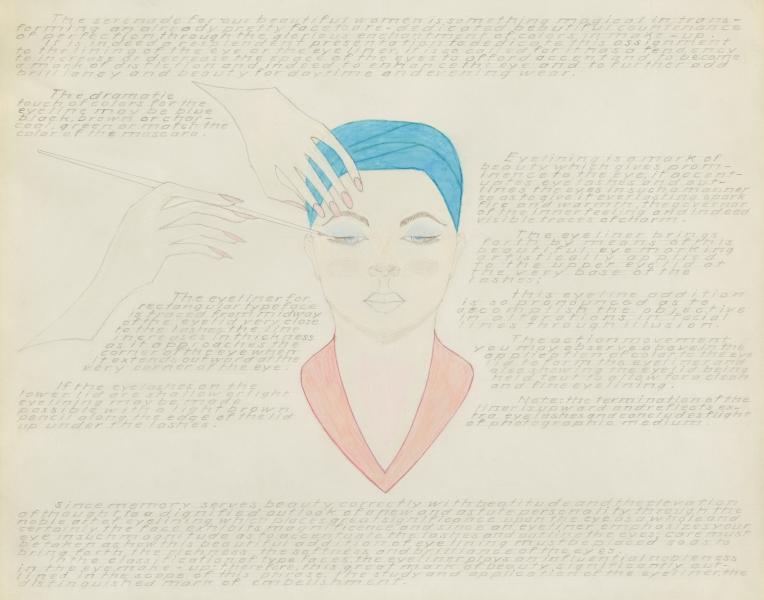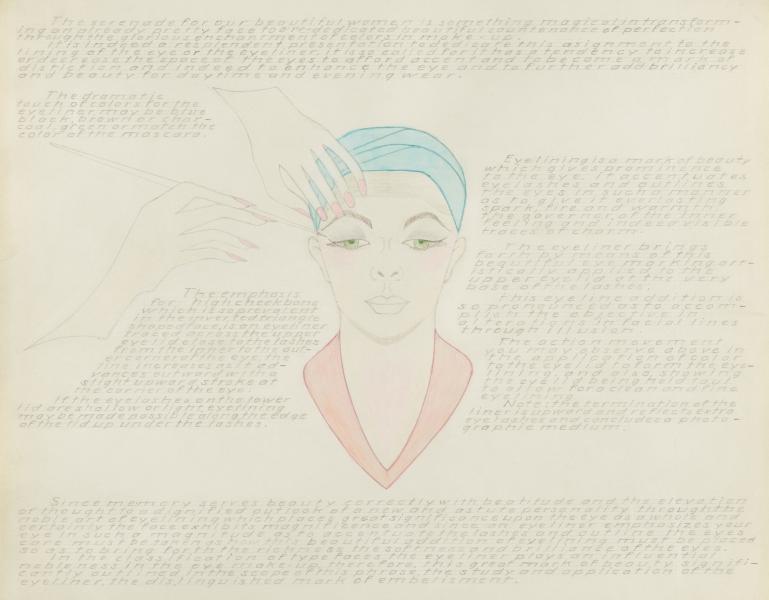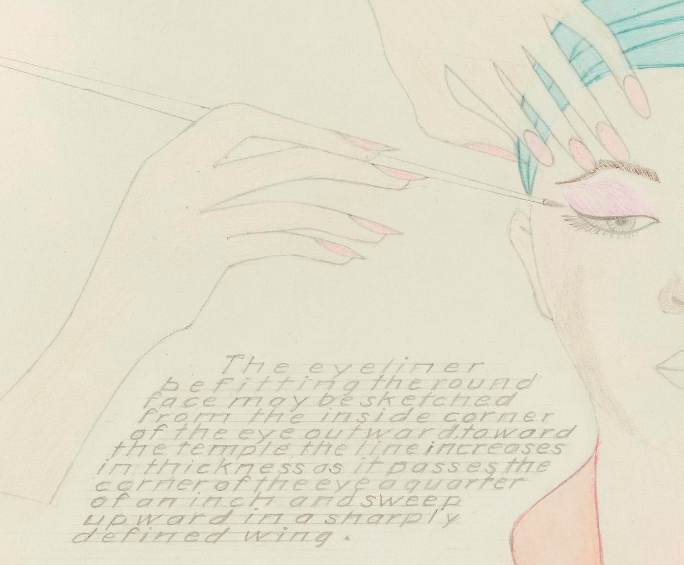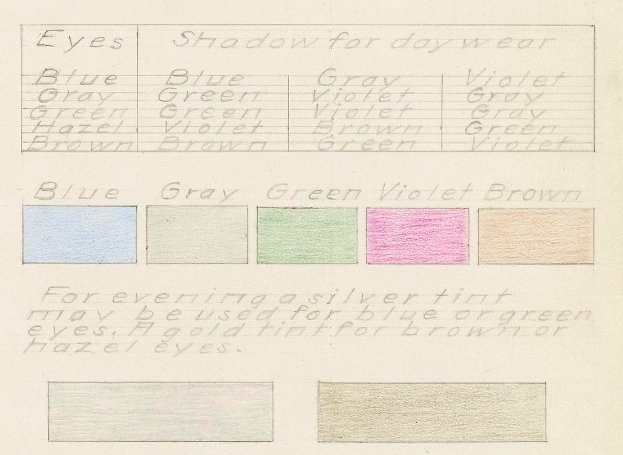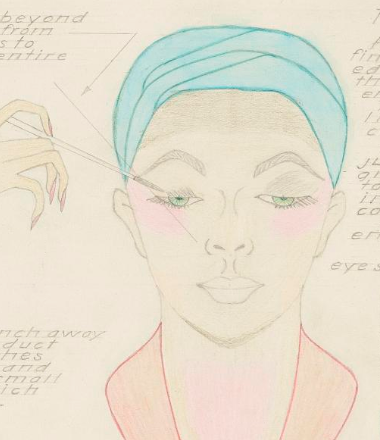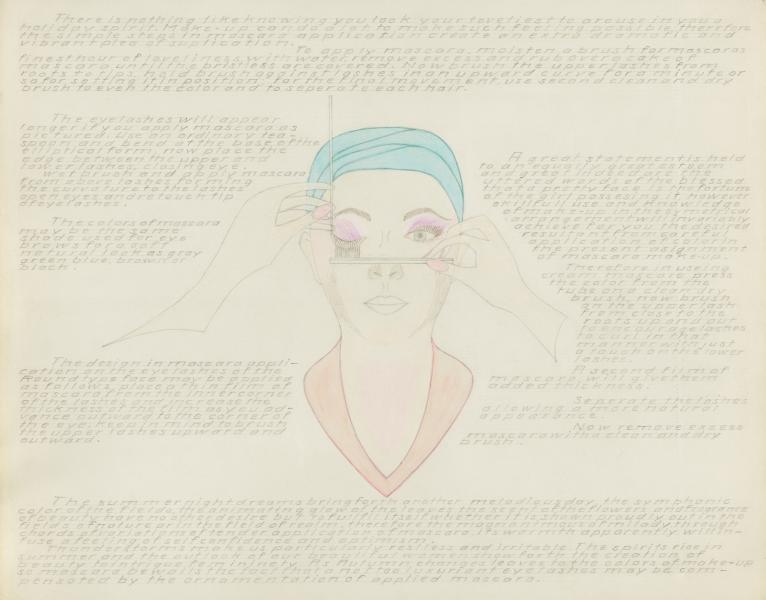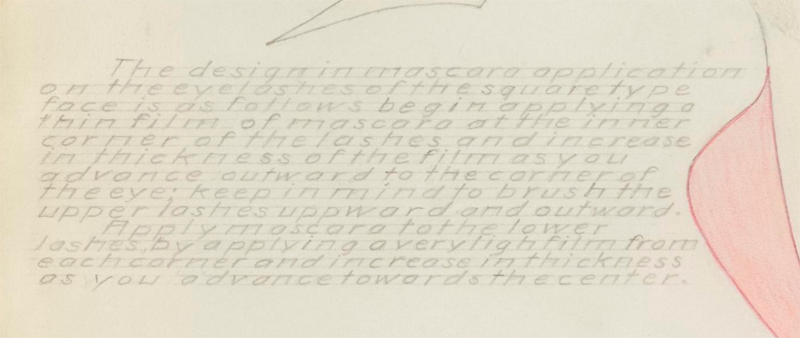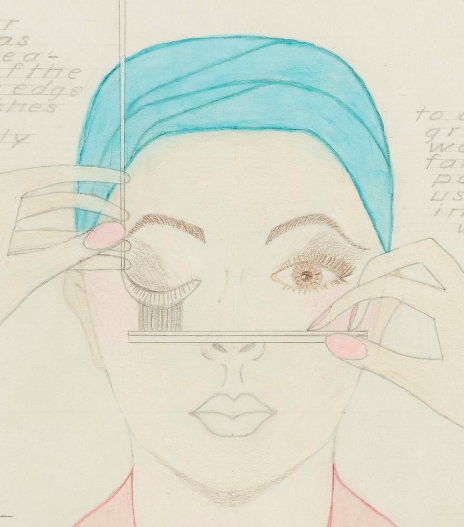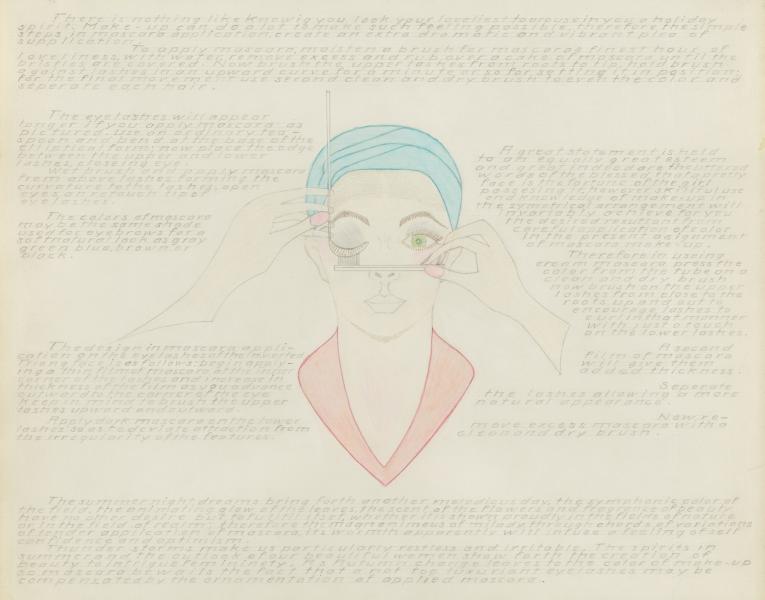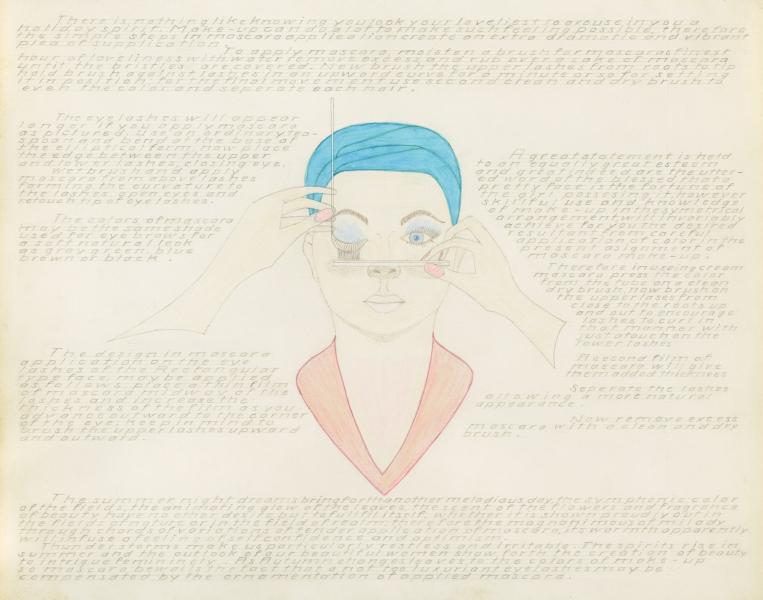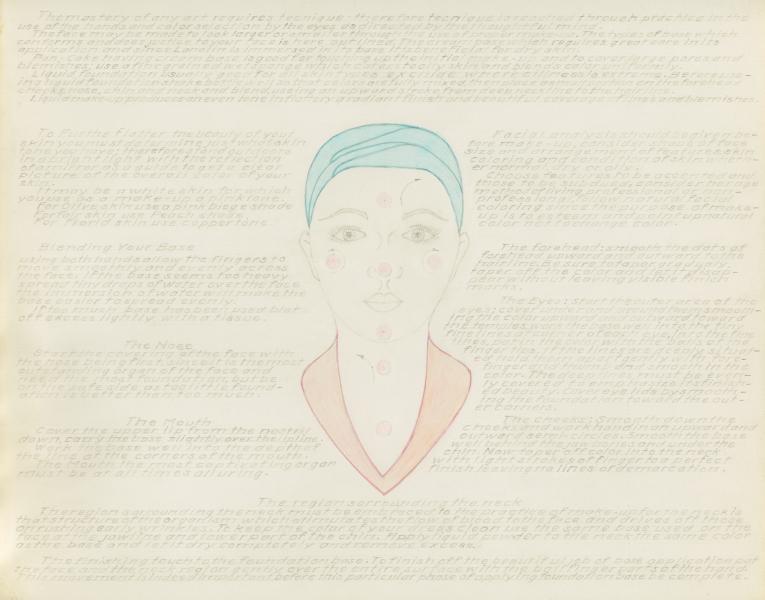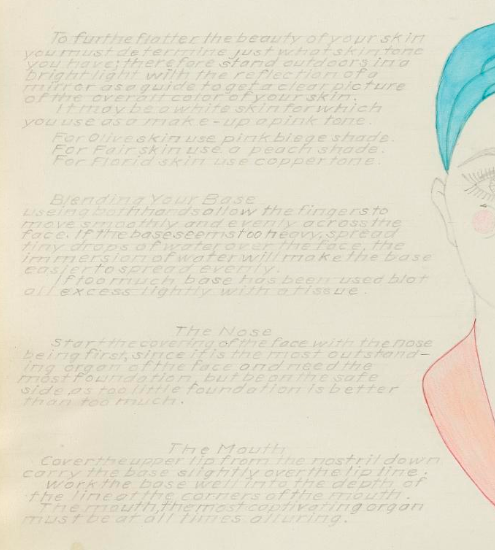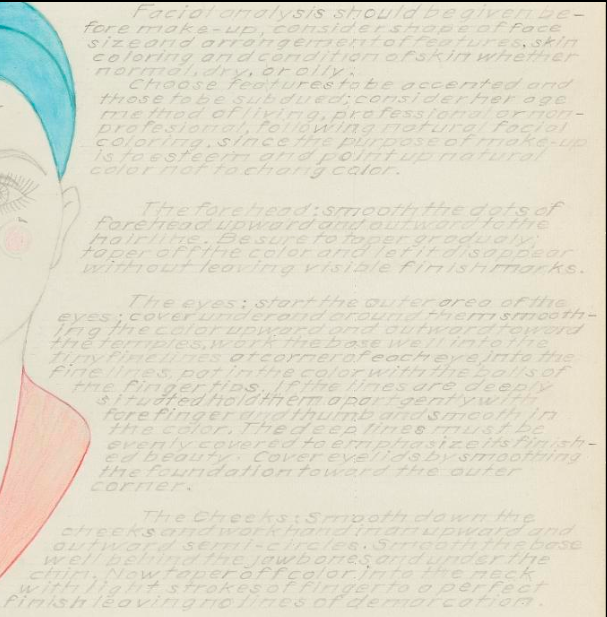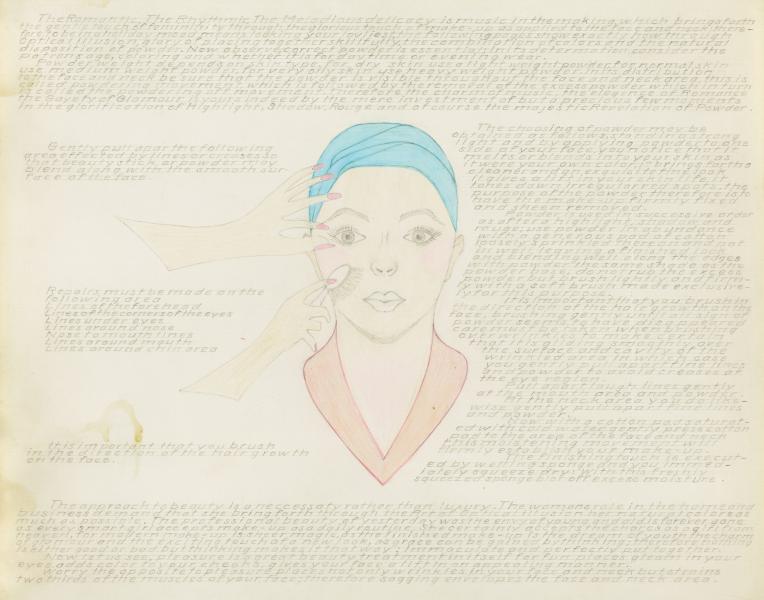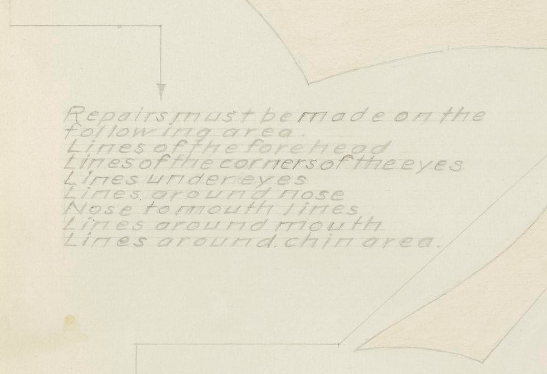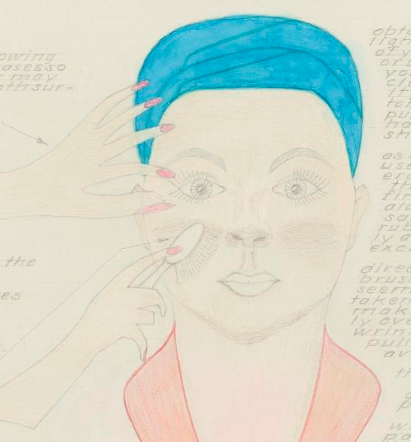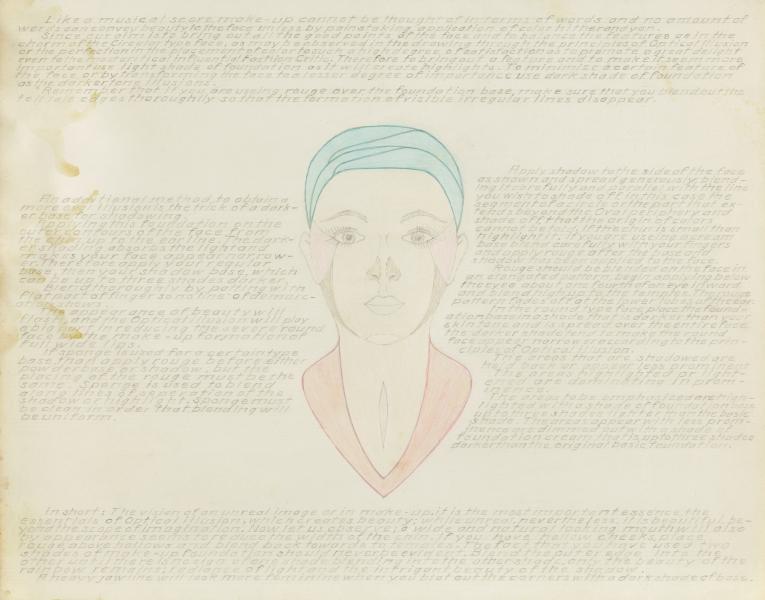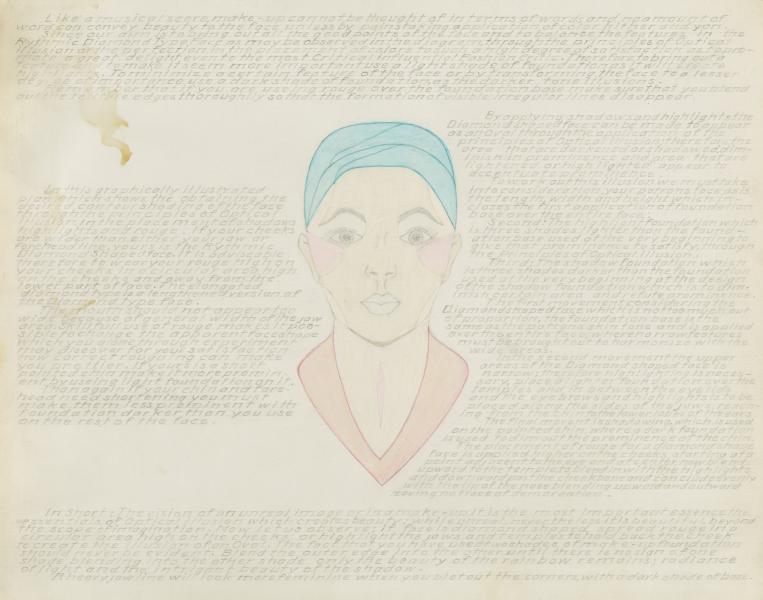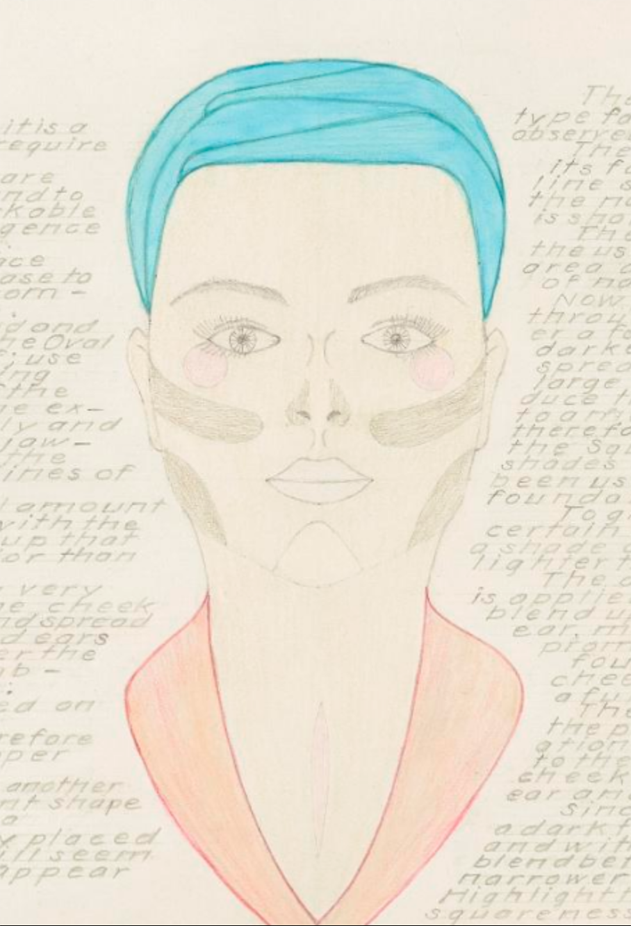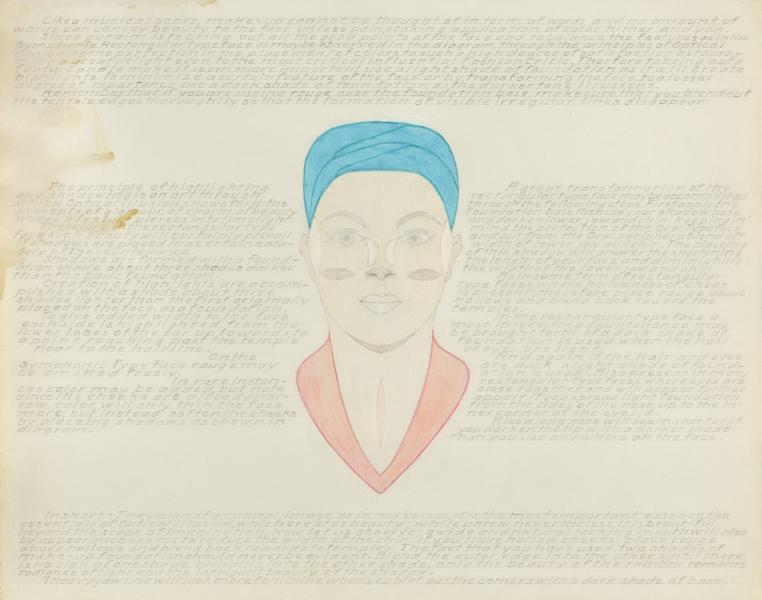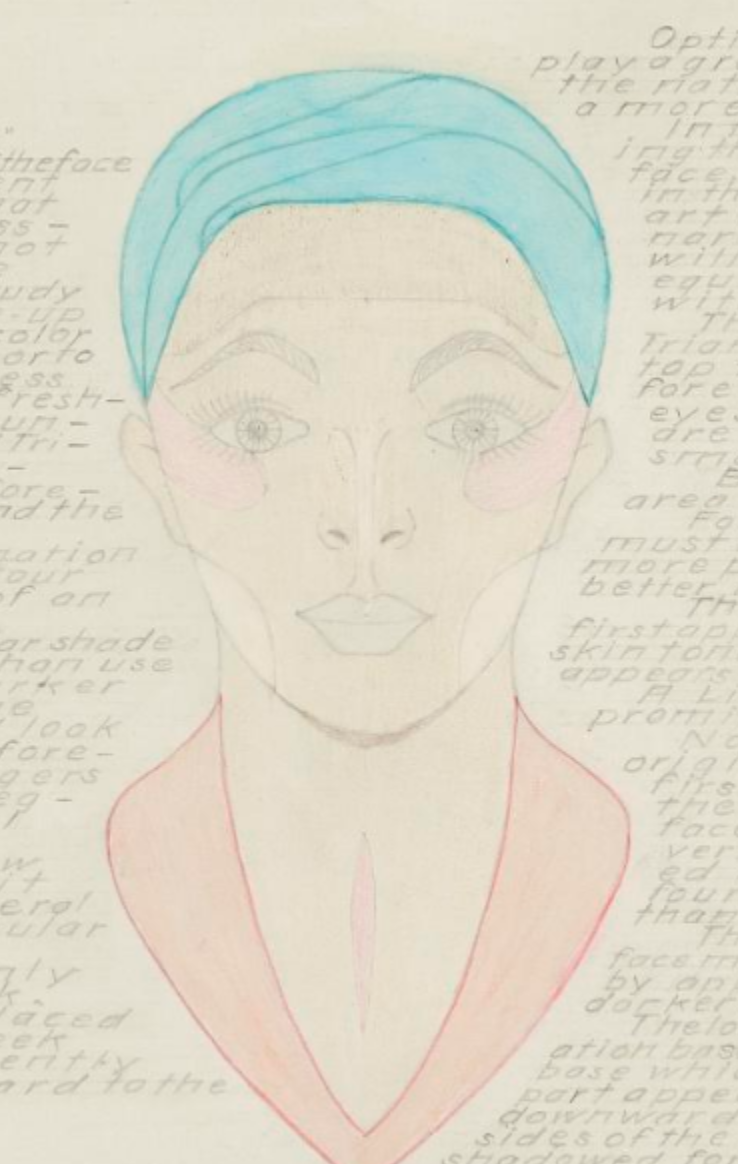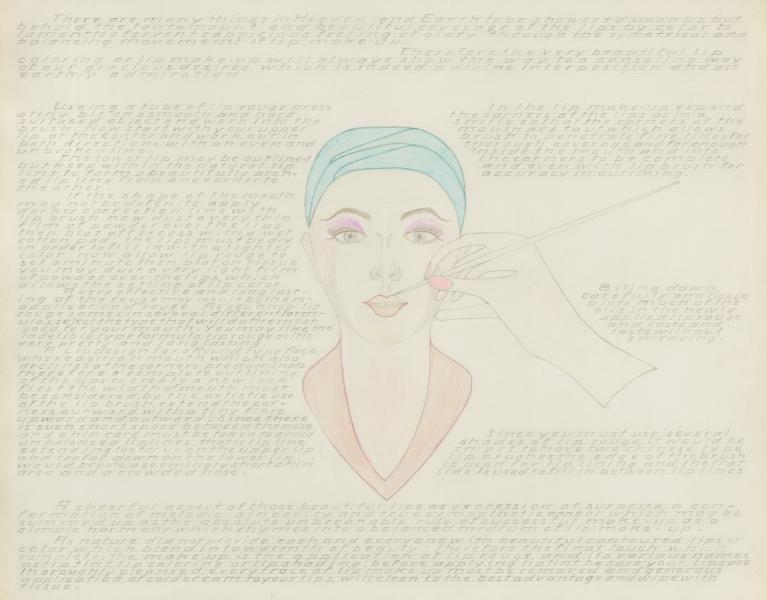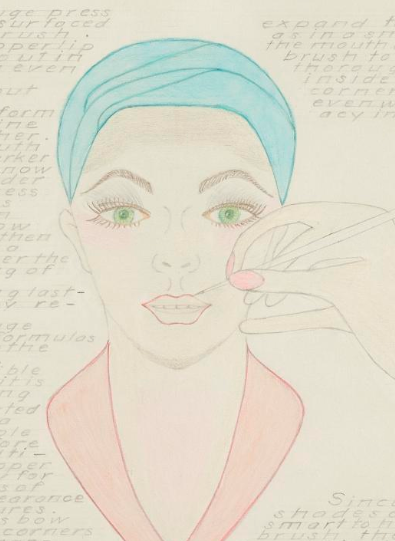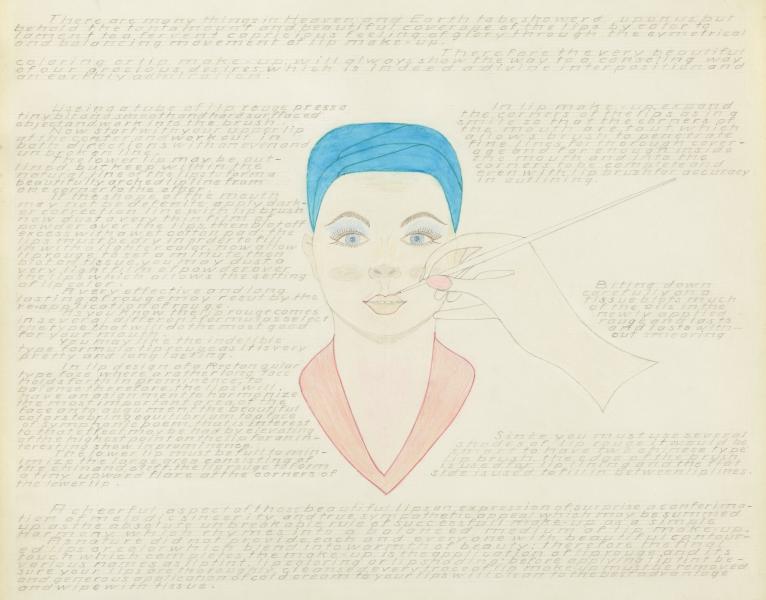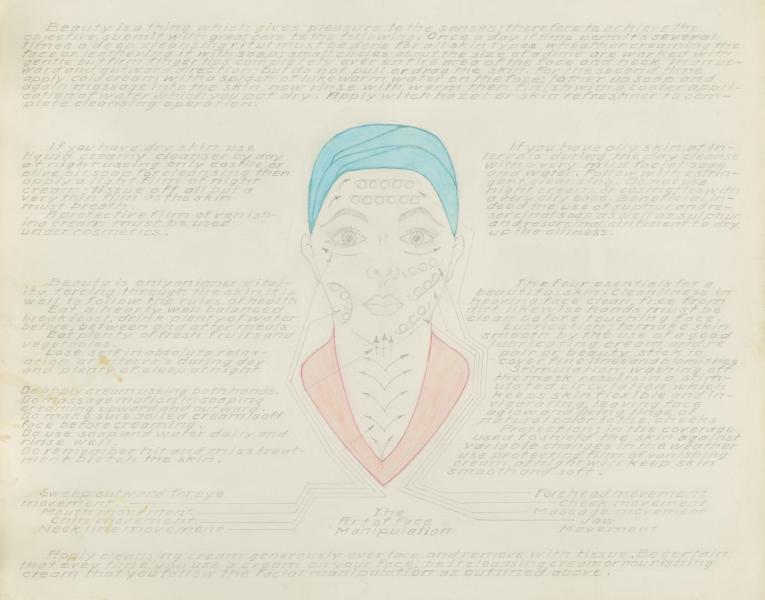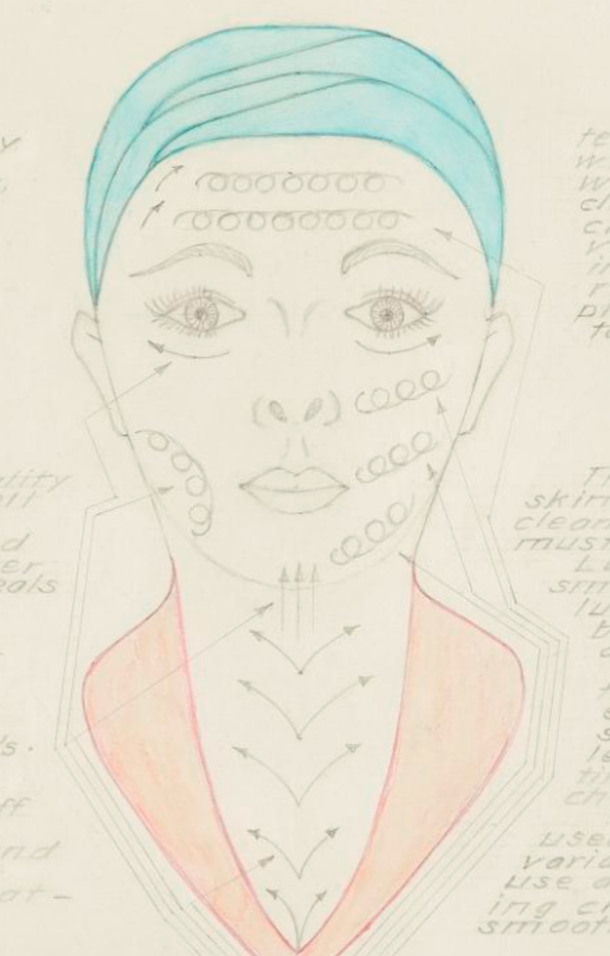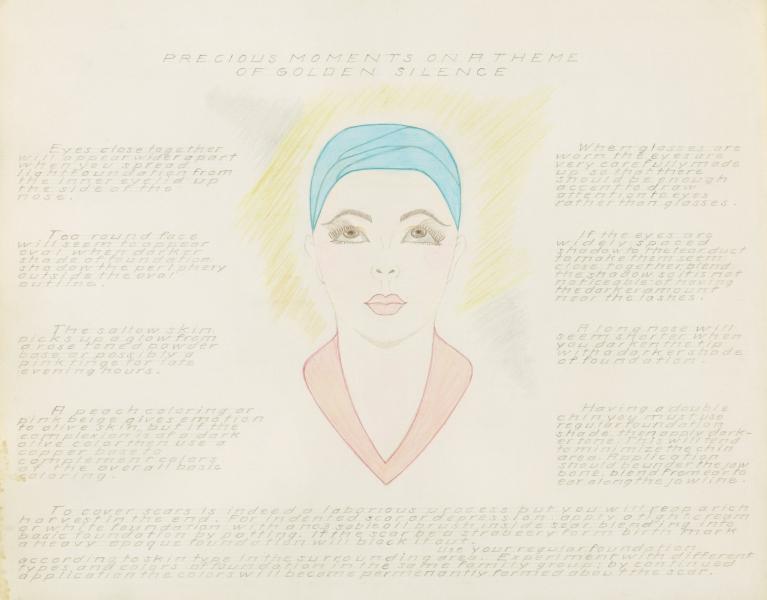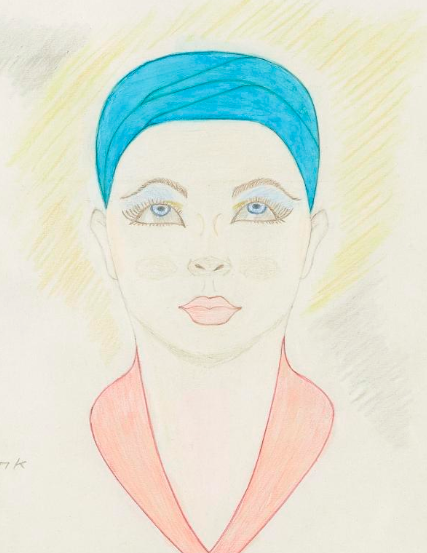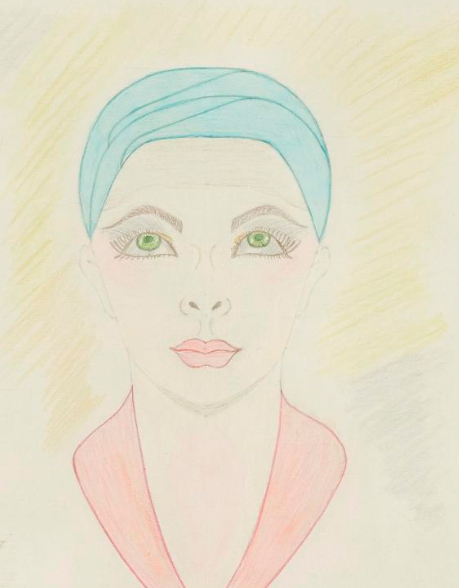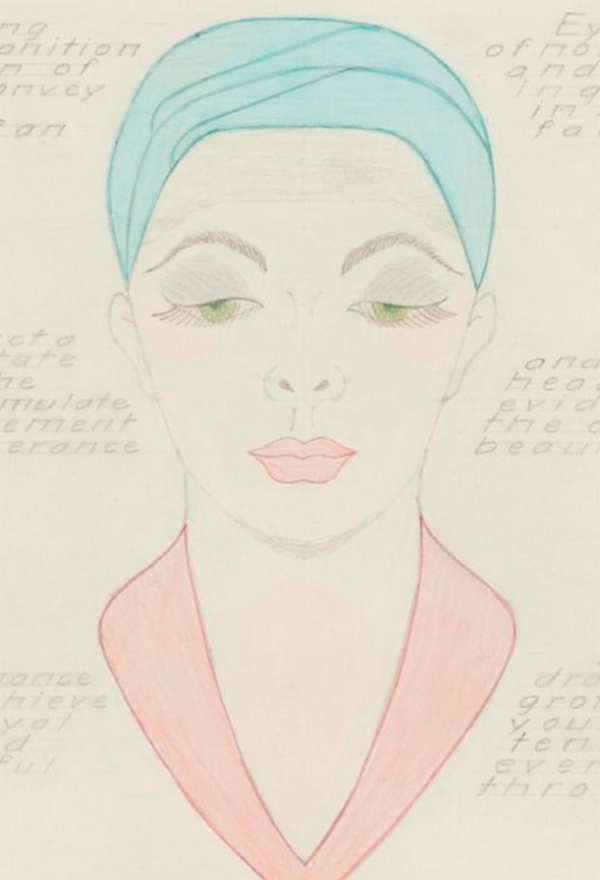If you haven't already checked out Beauty and the Cat's blog, I highly recommend it – not only is this duo chock full of useful information on beauty, they're hilarious to boot. A few months ago they posted some very interesting makeup drawings on their IG stories and naturally I had to find out more about them. After Beauty and the Cat assured me they weren't going to write about them and gave me their blessing to do so (I don't want to steal other bloggers' potential content!) I decided to forge ahead with a post on the illustrated makeup guides of Alexander Bogardy (1901-1992). The self-taught Bogardy has been classified as both an outsider artist and a folk artist, which is evident in his simplistic style.
Bogardy was born in Hungary, most likely in 1901*. His family came to the U.S. when he was a small child and settled, of all places, right here in Baltimore. He was a man of many talents, studying violin at the Peabody Conservatory (which is a block away from Museum headquarters!) in the 1920s, and in the '30s he had switched to boxing, becoming a prize fighter known as "The Baltimore Kid". By the '40s he had moved to DC to study mechanical engineering at George Washington University and worked as a machinist in the U.S. Naval Gun Factory. Unfortunately, crippling arthritis forced him into early retirement in 1952. It was during this time that Bogardy began taking painting and cosmetology classes, as he was encouraged by his doctors to continue doing some light activity with his hands to stave off further deterioration from the arthritis. While it's not certain if he actually worked at a salon, he certainly cut and colored the hair of his close friends and family, and often gave away his paintings to them. A lifelong devout Catholic – he attended mass every single day – most of his work depicted Biblical stories and religious figures. Personally, I'm an atheist who never had any interest in religious imagery (despite having somehow attended two Jesuit universities – go figure), but I'm struck by the female figures in Bogardy's paintings. The women are usually shown sporting full-on makeup, brightly painted fingernails and perfectly coiffed hair, reflecting his fascination with beauty rituals.
In 1962 Bogardy completed a booklet on hair styles and general hair care entitled "The Hair and its Social Importance". It served as both a hair care guide and an outline of his cosmetology accomplishments, including his diploma from Warflynn Beauty College in DC and a letter from the Clairol Institute regarding a hair coloring competition he had entered a decade earlier. He didn't win, but just the fact that he had received any type of correspondence following up on the competition made him believe he was an award-winning hair color expert, and only served to intensify his joy of sharing his cosmetology expertise with others. As historians Margaret Parsons and Marsha Orgeron note in this article in Raw Vision magazine, "It is certainly a feature of the art of Bogardy’s self-styling that he perceived recognition in so many guises, and that he derived so much apparent pleasure and pride from sharing with others an appreciation of his work in the applied crafts of cosmetology." They also speculate that part of Bogardy's interest in cosmetics came from his Hungarian heritage. "Born in 1902, he was about the same age as two American beauty tycoons of Hungarian origin, Erno Laszlo and Estée Lauder. The distinctive successes of these two, who were both from working-class immigrant families, would have appealed to Bogardy’s sense of ethnic pride and upward mobility."
After some 20-odd years of painting and illustrating, sometime in the 1970s, Bogardy abandoned his artistic pursuits to take up flamenco dancing. It makes sense given how diverse his interests were, and the fact that he comes across as fairly eccentric. Speaking of which, let's get to the makeup illustrations, shall we? According to the Smithsonian, where I was able to gather all the images, these illustrations were completed sometime between 1960 and 1970 and consisted of pencil drawings on 11" x 14" paper. They were divided into five sections showing five basic face shapes, and were further broken down into makeup categories – brows, mascara, eyeshadow and liner, foundation, powder, lip color, and blush, highlighter and contour placement – and provided detailed instructions for each facial type. At the top of each face type illustration Bogardy writes a short thought on female beauty, and at the bottom explains how to identify a particular face shape. While the face shapes differ, the eyebrow advice on each side is the same: "To find where the brows are to start, hold a straight line up from the nose on either side and remove stragglers in the middle. Pluck brows from below. The termination of the brow toward the temple must not reach past the line of observation drawn from the tip of the nose to the outer corner of the eye and continue upward beyond the end of the brow. This point of intersection where the line of observation crosses the eyebrow is therefore the length of the brow." Interestingly, this advice is more or less still prescribed today – you can find where your brows should start and end by lining up a pencil on the side of your nose.
Here's the "circular type face":
The "rhythmic diamond type face":
The "symphonic rectangular type face":
The "melodious square type face":
And finally, the "Romantic Inverted Triangle type face":
The drawings are a pleasure to behold, with the technicality and precision of their lines demonstrating Bogardy's previous experience in engineering. This is a bit of a contrast to the messy, sometimes confusing prose surrounding them. Though it's neatly rendered, as well as being historically useful in that it might shed some additional light onto beauty schools' curricula during the '50s, overall the text reads like a beauty- and religion-inspired word salad. Spiritual or mystical references are scattered throughout basic beauty tips. As Parsons and Orgeron put it, "Delicate disembodied hands hold small brushes and apply make-up to mannequins. Around the edges are animated and often incoherent lessons on female beauty, godliness and the finer points of cosmetic application." I'm glad I'm not the only one who couldn't quite grasp what he was trying to say! Bogardy began each section of the beauty notebook with drawings entitled "propitious and serene countenance of providential. sequel". I honestly have no idea what he what that means – perhaps it was an opening prayer for a book of makeup psalms. The rest of the text on these pages addresses the features and makeup that will be discussed in the coming sections.
"Eyelashes: the prancing the dancing and gliding admonition of youth, the manifestation of joyful and hilarious entity convey forth envious intensity of astonishment in its blaze of enthusiastical beauty."
"Eyebrows: A vivacious design of nobleness in the accentuation and the grandeur of the eye in quest of endearment in the field of esthetic faculty."
"Eyeshadow: the gracious and dignified ornamentation heads symbolism of external evidence of confiding in the ostentation of perspicuous beauty."
"Eyeliner: heighlights [sic] and dramatizes the eye in a grotesque illusion of flight the youthful significance of tender years to glow in the evening and glitter throughout the night."
"Lips: Relaxed lips reflect a picture on which to meditate a medly [sic] of vibrant colors, the stimulating emotion formulate a decisive allure in encouragement to feminity and the furtherance in lineation of lip beauty."
"Facial contour: in the summarization of the countenance of milady correlate to achieve the distinctiveness of portrayal to emulate your imported perfection in the beautiful design of the face."
"The assemblage of vigoration, even though by modification yet it is the doctrine of enlightenment to augment or diminish the augur passion for a tenacious existance [sic] in the world of the beautiful."
For your reading pleasure I have also transcribed most of the lengthy text for the makeup categories – thank goodness the Smithsonian offers a zoom feature so I could get up close. This was not nearly as painstaking as I imagine it was for Bogardy to write out the same text for each and every drawing. At first I thought he had traced it somehow, but upon further inspection it looks like he wrote out the same text for each individual illustration, changing only a few sentences related to face shape.
Let's start at the top of the face with the brows and work our way down the face. The text at the top for each one reads: "Eyebrows the arch of beauty, the setting character of the face, its revealing charm add untold and neverending joy to the make-up, in the presentation of beautiful facial lines. Since its great importance creates determination in your expression it must indeed add to the characteristic in the beautification of the face and further add sublimity to the countenance; beautifully arched eyebrows accentuate to the lovliness [sic] of your forehead, the revelation of your personality the irresistable [sic] magnetism the captivating power to eliviate [sic] and achieve beauty in facial transformation far removed from your fondest dream. One look at your artistically shaped brows will invite another and most certainly a delightfully furtive look and lo, the deliverance of a beauty into the arms of beau monde."
"Feminine allure means make-up in its entirety a beautiful figure together with make-up, so artistically blended as to modulate a peerless extravaganza, therefore, the eyebrow make-up, eyebrows should start at a point and above and even with the eye duct and the eyebrows terminate at the line of observation, drawn from the flare of the nose to the outside corner of the eye and upward to the temple. To be in unison with the above paragraph you must have natural brow line for it is the eyebrows which give that authentic and picturesque expression to the face. Use dark brown brow pencil on dark, red and naturally black brows, use light brown on blond brows. Sharpen your brow pencil with a razor blade, trace brows with a short sketchy hairlike stroke, to assume brow lashes; after penciling, brush your brows gently with an eyelash brush to soften the brow line and should follow your natural line."
The text on the right side provides brow instructions for that particular face shape, while the left side drawing indicates the measurements for the brow arch. I adore how scientific and precise the diagram is.
Next up is eyeliner. Top and left side text: "The serenade for our beautiful women is something magical in transforming an already pretty face to a re-dedicated beautiful countenance of perfection through the glorious enchantment of colors in make-up. It is indeed a resplendent presentation to dedicate this asignment [sic] to the lining of the eye or eyeliner, it is so called for it has a tendency to increase or decrease the space of the eyes to afford accent and to become a mark of distinction and indeed to enhance the eye and to further add brilliancy and beauty for daytime and evening wear. The dramatic touch of colors for the eyeliner may be blue black; brown or charcoal, green or match the color of the mascara."
"Eyeliner is a mark of beauty which gives prominence to the eye, it accentuates eyelashes and outlines the eyes in such a manner as to give it everlasting spark, fire and warmth, the governor of the inner feeling and indeed visible traces of charm. The eyeliner brings forth by means of this beautiful eye marking artistically applied to the upper eyelid at the very base of the lashes; this eyeline addition is so pronounced as to accomplish the objective in alterations in facial lines through illusion. The action movement you may observe above in the application of color to the eyelid to form the eyelining, and also showing the eyelid being held taut to allow for a clean and fine eyelining. Note: the termination of the eyeliner is upward and reflects extra eyelashes and concludes a photographic medium."
"Since memory serves beauty correctly with beatitude and the elevation of thought to dignified outlook of a new and astute personality through the noble art of eyelining which places great significance upon the eye as a whole and certainly the face exhibits magnificence and since an eyeliner emphasizes your eye in such a magnitude as to accentuate the lashes and outline the eyes care must be taken as to how this beautiful addition of eyelining must be placed so as to bring forth the richness the softness and brilliance of the eyes. In the classification of type faces the eyeliner plays an influential nobleness in the eye make-up, therefore this great mark of beauty significantly outlined in the scope of this phrase, the study and application of the eyeliner, the distinguished mark of embellishment."
This time the individualized instructions are on the left side of the drawing.
Moving onto eyeshadow, here's the text at the top: "Glamor an artifice of glorification, mistified [sic] by the magic touch of color nourished by imagination and placed high upon the scale of beauty, through the medium of optical illusion, thereby improving upon the gift of nature. She alters her face with paints and powder, lighting her face and a pinkish touch she adds and behold she darkens her brows and brightens her lids; therefore the ladylike look is certainly high fashion, for it depends on flawless grooming for that smooth, young and luminous look effervescence of the eyeshadow which creates the illusion of depth and expresses your mood. We cannot stress the point to [sic] strongly and to enumerate an eyeshadow to enhance the color of the eyes to compliment the eyelashes and to make your eyes what you want them to be, an illusion of beauty of charm and of course the window of endearment and beau ideal for naturally yet flattering look of a modern girl."
"Do not extend eyeshadow beyond line of observation, draw from the outer corner of the eyes to end of eyebrow covering entire eyelid. Apply eyeshadow 1/8 inch away from the inner corner of eye duct along the top of eyelashes with an upward motion and blend sidewise useing [sic] a small brush if you prefer one which indeed is a good practice."
"The chick [sic] face technique of applying eyeshadow. Apply eyeshadow with your little finger then sponge pat over the shadowed area to achieve that subtlety accent that is shadow gives eyes more depth, emphasis and color. To elaborate therefore; with your little finger place a thin layer along the lashes as shown. Now spread upward and outward just to the tip of the eyebrows graduating the shade from dark tone upward to a lighter tone; immediately the eyes become colorful, larger and radiant. Experiment: it is good experience and excellence in grooming."
For daytime wear Bogardy recommended green, grey, violet, blue and brown depending on eye color ("used sparingly"), and advised adding a hint of metallic glam for nighttime: a "silver tint" for green or blue eyes and gold for brown or hazel.
"A delicate issue is at hand when applying brown eyeshadow for its application is intricate; to distribute a heavy layer of eyeshadow a hurried or unskilled method will most certainly age the face, therefore; in a skillfull [sic] manner apply a delicate tint of brown from the upper from the upper half of the eyelid to the eyebrows; then use a green or blue as indicated above on the chart and spread from the lashes and lower lid and blend with brown eyeshadow of the upper lid. A systematic arrangement of placing eyeshadow, is to smooth liquid foundation on eyelid first, then the shadow then dust on a little powder. This tones down the color and keeps eye lashes from smearing, assuring a firm and beautiful eyeshadow make-up."
Next up are the lashes. "There is nothing like knowing you look your loveliest to arouse in you a holiday spirit. Make-up can do a lot to make such feeling possible; therefore, the simple steps in mascara application create an extra dramatic and vibrant plea of suplication [sic]. To apply mascara, moisten a brush for mascaras finest hour of loveliness with water, remove excess and rub over a cake of mascara until the bristless [sic] are covered. Now brush the upper lashes from roots to tips, hold brush against lashes in an upward curve for a minute or so for setting it in position; for the final movement, use second clean and dry brush to even the color and to separate each hair."
The instructions for each face shape are provided in the lower left.
"The eyelashes will appear longer if you apply mascara as pictured. Use an ordinary tea spoon and bend at the base of the elliptical form; now place the edge between the upper and lower lash closeing eye. Wet brush and apply mascara from above lashes, forming the curvature to the lashes, open eyes, and retouch tips of eyelashes." Has anyone ever tried the spoon trick? I've always used a regular eyelash curler.
The right side text consists of some very wordy instructions for simple mascara application: "A great statement is held to an equally great esteem and great indeed are the uttered words of the blessed that a pretty face is the fortune of the girl possessing it, however skillful use and knowledge of make-up in the symmetrical arrangement will invariably achieve for you the desired resultant from careful application of color in the present asignment [sic] of mascara make-up. Therefore in useing [sic] cream mascara press the color from the tube on a clean dry brush, now brush on the upper lash from close to the roots up and out to encourage lashes to curl in that manner with just a touch on the lower lashes. A second film of mascara will give them added thickness. Seperate [sic] the lashes allowing a more natural appearance. Now remove excess mascara with a clean and dry brush."
"The summer night dreams bring forth another melodious day, the symphonic color of the fields, the animating glow of the leaves the scent of the flowers and fragrance of beauty have no other desire but to fulfill itself whether it is shown proudly out in the chords of variation of tender application of mascara, its warmth apparently will infuse a feeling of self-confidence and optimism. Thunderstorms make us particularly restless and irritable. The spirits rise in summer and the outlook of our beautiful women show forth the creation of beauty to intrigue femininety [sic]. As autumn changes leaves to the colors of make-up so mascara bewails the fact that a not too luxuriant eyelashes may be compensated by the ornamentation of applied mascara." Okey dokey.
And now we're onto the face, starting with foundation. "The mastery of any art requires tecnique [sic] therefore tecnique [sic] is reached through practice in the use of the hands and color selection by the eyes as directed by the thoughtful mind. The face may be made to look larger or smaller through the use of proper make-up. The types of base which conforms and does justice to your face is here outlined. The cream base which requires great care in its application and since lanolin is immersed in its base it is beneficial for dry skin. Pan-cake having cream base is good for touching up the initial make-up and to cover large pores and blemishes; use a fine grained wet sponge which caters to oily skin and blends color uniformly. Liquid foundation usually good for all skin types exclude where oiliness is extreme. Before useing [sic] liquid foundations shake bottle well so that colors are fully mixed, then place a small portion on the forehead, cheeks, nose, chin and neck and blend, useing [sic] an upward stroke from deep neckline to the hairline. Liquid make-up produces an even tone in flattery a radiant finish and beautiful coverage of lines and blemishes."
Bogardy's foundation application tips (I was getting really tired of typing it all out so I just did screenshots of these).
Next, Bogardy advises on the application of face powder. Top text: "The Romantic, the Rhythmic, The Melodious delicacy is music in the making, which brings forth the gentle touch of femininity through the glorious touch of make-up as applied to the face and neck; therefore, to be in a holiday mood means looking your lovliest [sic], the following pages show exactly how through optical illusion, glory of placing together skillfully the combination of colors and the natural disposition of powder. Now observe, correct powder is essential; in its determination consider the patron's age, coloring and whether it is for daytime or evening wear. Powder weight depends on skin type, for dry skin use a light weight powder for normal skin use medium weight powder, for very oily skin use heavyweight powder. In its distribution to the face and neck be sure that the powder is visible throughout the face and neck area; this is called powdering movement, which is followed by the removal of the excess powder, which in turn is called the powdering off movement. Therefore, the charm of music, the elegence [sic] of Romance, the Gayety [sic] of Glamour is yours indeed, by the mere investment of but a precious few moments in the glorification of Highlight, Shadow, Rouge and of course the Majestic Revelation of Powder." That's certainly a spirited way of looking at face powder, yes?
The text on the right side includes useful application tips for, ahem, mature women – don't want that powder getting caught in all your wrinkles! "The choosing of powder may be obtained as follows: stand in a strong light and by applying powder to one side of your face you notice that it melts or blends into your skin as if it were your own color, it brings forth a cleaner and an exquisite fine look it gives a lift in your skin life, it tones down irregular red spots, the purpose of the powder therefore is to have the make-up firmly fixed and sheen removed. Powder is used in successive order as after highlights, shadow and rouge, use powder in abundance with a generous pad of cotton loosly [sic] sprinkled there on and pat in well leaving a finished look and blending well along the edges, with powder the same shade as the powder base do not rub the excess powder, but brush lightly and firmly with a soft brush made exclusively for this purpose. It is important that you brush in the direction of the hair growth on the face brushing gently until all sign of powder seems to have disappeared, care must be taken when brushing over wrinkles, to make certain that it is gliding smoothly over the surface and the cavity of the wrinkled area in which case you gently pull apart fine lines and powder to avoid creases at the eye region. Pull apart laugh lines gently at the mouth area and powder. At the neck area you do likewise gently pull apart fine lines and powder. Now with a cotton pad saturated with cold water gently press cotton pad to the area of the face and neck, this moistening movement will firmly establish your make-up. The finishing touch is executed by wetting sponge and you immediately squeeze dry. With this freshly squeezed sponge blot off excess moisture."
"The approach to beauty is a necessity rather than luxury. The woman's role in the home and business demand that she bring forth through the art of optical illusion her natural color as much as possible. The professional beauty of yesterday was the envy of young and old is forever gone as every smart girl accepts make-up as a daily routine. She certainly accepts the chores as a girl from Heaven, for modern makeup is sheer magic, as the finished makeup is the dream of youth, the charm of glamour and the exciting touch of a new look, as grace can be gained by thinking; therefore nothing is either good or bad but thinking makes it that way; immaculate and perfectly put together. Now let us see, pleasure is a great beauty treatment in itself for fun places gleam in your eyes adds color to your cheeks, gives your face a lift in an appealing manner. Worry the opposite to pleasure, places not only wrinkles in your face and neck but strains two thirds of the muscles of your face; therefore sagging envelopes the face and neck area."
The next section is particularly interesting as it reveals the secrets of old-school contouring and highlighting through the use of lighter or darker foundation. Top text: "Like a musical score, make-up cannot be thought of in terms of words and no amount of words can convey beauty to the face unless by painstaking application of color hither and yon. Since our aim is to bring out all the good points of the face and to balance the features as in the Circular Type face as may be observed in the diagram, through the principles of optical illusion or the perfection in the placement of colors to such a high degree of satisfaction as to promote a great delight even to the most critical influential fashion critic. Therefore to bring out a feature and to make it seem more important use a light shade of foundation as it will create highlights. To minimize a certain feature of the face or by transforming the face to a lesser degree of importance use a dark shade of foundation as the darker tone illusions. Remember that if you are useing [sic] rouge over the foundation base, make sure that you blend out the tell tale edges thoroughly so that the formation of visible irregular lines disappear." The bottom text reads, "In short: the vision of an unreal image or in make-up, is is the most important essence, the essentials of optical illusion, which creates beauty; while unreal nevertheless, it is beautiful beyond the scope of imagination. Now let us observe; a wide and natural looking mouth will also by appearance seem to reduce the width of the chin. If you have hollow cheeks, place rouge above hollows and blend back towards to temples. The fact that you have used two shades of make-up foundation should never be evident. Blend the outer edge into the other until there is no sign of one shade blending into the other shade, only the beauty of the rainbow remains radiance of light and the intrigant [?} beauty of the shadow. A heavy jawline will look more feminine when you blot out the corners with a dark shade of base."
Again, I was getting too tired to type up all the text, but I've linked to each one so you can zoom in to see the advice for each face type.
I saved the lips for last. Again, Bogardy emphasizes the importance of lip color as another tool for balancing the rest of the facial features. Top text: "There are many things in Heaven and Earth to be showerd [sic] upon us, but behold the tantamount and beautiful coverage of the lips by color to lament to a fervent capricious feeling of glory through the symetrical [sic] and balancing movement of lip make-up. Therefore the very beautiful coloring or lip make-up will always show the way to a consoling way of our gracious desires which is indeed a divine interposition and an earthly admiration."
"Using a tube of lip rouge press a tiny bit on a smooth and hard surffaced [sic] object and work into the brush. Now star with your upper lip at the center and work out in both directions with an even and unbroken line. The lower lip may be outlined, but keep within the natural line of the lips to form a beautifully arched lip line from one corner to the other. If the shape of the mouth may not be defenite [sic] apply darker correction line with lip brush now dust a very thin film of powder over the lips then blot off excess with a wet cotton pad; the lips must be dry in order to fill in with a lighter color, now allow lip rouge to set a minute, then blot on tissue, you may dust a very light film of powder over the lips which allows the setting of lip color. A very effective and long lasting of rouge may result by the re-application of rouge. As you know the lip rouge comes in several different formulas select the type that will do the most good for your mouth. You may like the indelible type formula lip rouge as it is very pretty and long lasting."
Right side text: "In lip make-up, expand the corners of the lips as in a smile so that the corners of the mouth are taut, which allows brush to penetrate fine lines for thorough coverage and far enough inside the mouth and into the corners to be complete and even with lip brush for accuracy in outlining. Biting down carefully on a tissue blots much of the oils in the newly applied rouge and lasts and lasts without smearing."
Bottom text: "A cheerful aspect of those beautiful lips an expression of surprise a confirmation of melodious sincerity and true sympathetic appeal which may be summed up as the absolute unbreakable rule of successfull [sic] make-up as a simple harmony which rhymes into a balanced medium of lip make-up. As nature did not provide each and everyone with beautiful contoured lips or color which blend into warmth of beauty; therefore the final touch which completes the make-up is the application of a lip rouge and its various names as lip tint, lip coloring or lip shading; before applying lip tint be sure your lips are thoroughly cleansed, every trace of lip make-up must be removed and generous application of cold cream to your lips will clean to the best advantage and wipe with tissue."
As with the others, brief tips at the end of the left-side paragraph are included for each facial type. Here's an example for the rectangular type: "In lip design of a rectangular type face where a rather long face hold forth in prominence, to balance therefore the lips will have an asignment [sic] to harmonize the most important area of the face and to augment the beautiful colors to bring equilibrium to a face of symphonic poem, that is interest to that effect may be had by elevating of the highest point on the lip for an interesting show in prominence. The lower lip must be full to minimize the large area consisting of the chin and cleft, the lip rouge to form a tiny upward flare at the corners of the lower lip."
Bogardy's book had some skincare tips, which generally hold up fairly well in the 21st century. The text was the same for all so I did not include all the drawings of the different face shapes. "Beauty is a thing which gives pleasure to the senses; therefore, to achieve the objective, submit with great care to the following. Once a day if time permits several times a deep cleansing ritul [sic] must be done for all skin types wheather [sic] creaming the face or leathering [sic] it with soap; small circles about the size of a dime are worked with gentle but firm fingertips completely over entire area of the face and neck in an upward and outward direction; but do not pull or drag the skin. For the second time apply cold cream with a splash of lukewarm water on the face; lather up soap and again massage into the skin, now rinse with warm then finish with a cooler application of water which you pat dry. Apply witch hazel or skin refreshener to complete cleansing operation."
Left side text: "If you have dry skin use liquid creamy cleanser by day, at night useing [sic] only castile or olive oil soap for cleansing then apply a light film of night cream; tissue off all but a very thin film as the skin must breath [sic]. A protective film of vanishing cream must be used under cosmetics. If you have oily skin at intervals during the day cleanse with a very mild facial soap and water. Follow with estringent [sic] cleansing. Do not use night cream or cosmetics with a very oily base. Beneficial indeed the use of suphur [sic] and resorcinal ? soap as well as sulphur and resorcinal ointment to dry up the oiliness. Beauty is only an inner vitality forcing through the skin, it is well to follow the rules of health. Eat a hearty well balanced breakfast, drink plenty of water before, between and after meals. Eat plenty of fresh fruits and vegetables. Lose self in absolute relaxation at intervals during day and plenty of sleep at night. Do apply cream useing [sic] both hands. Do massage motion in soaping creaming upward and outward. Do make sure soiled cream is off face before creaming. Do use soap and water daily and rinse well. Do remember hit and miss treatment blotch the skin."
"The four essentials for a beautiful skin. Cleanliness in leaving face clean, free from dirt likewise hands must be clean before touching face. Lubrication: to make skin smooth by the use of a good lubricating cream and repair or beauty stick to cover fine lines and blemishes. Stimulation: washing off the mask results in a stimulated circulation which keeps skin flexible and invigorating, leaving face a glow and bring tinge of natural color to the cheeks. Protection: In the coverage used to shield the skin against variable changes in the weather use protecting film of vanishing cream at night will keep skin smooth and soft."
Bogardy concluded each section with drawings he titled "Precious moments on a theme of golden silence" showing each of the face types looking up and surrounded by rays of soft golden light. Given his religious bend, these women appear angelic (the light could be a halo) and the upward glance might be directed towards heaven. The idea of transforming oneself from mere mortal to angelic being via makeup is still strong today – I could probably write a book about the intersection of heaven, angels and makeup.
"Eyes close together will appear wider apart when you spread light foundation from the inner eyelid up the side of the nose. Too round face will seem to appear oval when darker shade of foundation shadow the periphery outside the oval outline. The sallow skin picks up a glow from a rose toned powder base or possibly a pink tinge for late evening hours."
"When glasses are worn the eyes are very carefully made up so that there should be enough accent to draw attention to eyes rather than glasses. If the eyes are widely spaced shadow to the tear duct to make them seem close together, blend the shadow so it is not noticeable of having the darker amount near the lashes."
"A long nose will seem shorter when you darken the tip with a darker shade of foundation. Having a double chin you must use regular foundation shade, then apply darker tone. This will tend to minimize the chin area. Application should be under the jawbone, blend from ear to ear along the jawline."
"To cover scars is indeed a laborious process but you will reap a rich harvest in the end. For indented scar or depression, apply a tight cream or white foundation with a no. 3 sable oil brush inside scar, blending into basic foundation by patting, if the scar be a strabeery [sic] form birth mark a heavy opaque foundation will block it out. Use your regular foundation according to skin type in the surrounding area. Experiment with different types and colors of foundation in the same family group: by continued application the colors will become permanently formed about the scar."
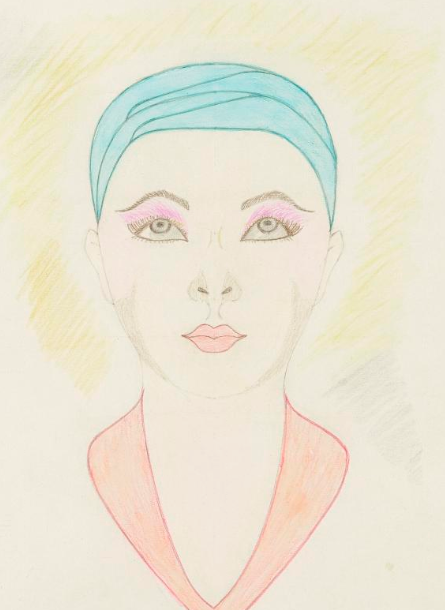
(images from the Smithsonian)
Stylistically, I'm surprised at how modern these look. If we ignore the ostensibly '60s era head wraps, the illustrations resemble toned-down versions of MAC face charts and others readily available today. As for the instructions, despite the lack of diversity (the face types shown are presumably white women, with no mention of varying skin tones or eye shapes), the basic principle of balancing one's features remain somewhat relevant today. Overall though, even after sifting through the roughly 60 illustrations made available by the Smithsonian, I was still not entirely sure what Bogardy's motivation was in producing these. "The Hair and its Social Importance" was a self-published booklet to be distributed among his circle and hopefully more widely to the public; it's not clear who these makeup drawings were intended for. Then it dawned on me: they were probably meant to be a makeup counterpart to the hair booklet, given that it was considered a "hair bible" and my earlier theory that the beginnings of each section comprised introductions for a sort of prayer book. Parsons and Orgeron confirmed my hunch. "[Our] research during the summer and fall of 2001 turned up approximately one hundred extant paintings and colored-pencil drawings – sketches Bogardy had apparently rendered for a handbook on female beauty and the proper application of cosmetics. This manual, if he had been able to publish it, would most likely have served as a companion volume 'The Hair and its Social Importance'". So it was really a matter of him not getting to publish it for whatever reason. In any case, Bogardy enjoyed making art for others and sharing his cosmetic expertise, but his admiration of women and their presentation of feminine beauty, his dedication to Catholicism and the appeal of daily rituals were really the impetus for the drawings. "His sense of ritual permeated his personal life, and he was passionate about helping women look beautiful–both for themselves and for God," note Parsons and Orgeron, adding, "Clearly, this is the art of makeup application raised to the level of religious ceremony."
Thus, the beauty book was simply a matter of combining the areas he was most passionate about during the '50s and '60s: cosmetology, art, and devotion to God. I believe Bogardy presents a unique take on conventional beauty wisdom of the time. I'm not wild about the idea of women looking their best for anyone but themselves – I don't think we have a duty to look pretty for fellow humans, let alone God, nor do I think women require makeup to feel beautiful – but his enthusiasm for the transformative nature of makeup application elevates one's beauty tasks from the mundane to the divine. As I noted earlier, I'm not the slightest bit religious or even spiritual, but I do feel like my makeup routine is a ritual of sorts, especially when I can take my time and fully enjoy the process. Bogardy's drawings express and celebrate the near-heavenly state makeup application can bring. In our current era of "self-care" and "wellness", they also serve as a reminder to carve a few moments in our busy schedules to do the things that make us feel valued and worthwhile. Taking pleasure in performing a beauty ritual, whatever it may be, is just as good for the mind as it is for appearance.
That was a lot to take in! What do you think of Bogardy's beauty illustrations? Would you use any of these techniques?
*The Smithsonian gives Bogardy's birth year as 1901, but some other sources say 1902. One of the articles referenced above lists his possible dates of birth as 1901, 1903, 1917 and 1924…although if the Peabody has records of him studying violin there during the '20s I doubt he could have been born in the 19 teens or '20s. Another article by the same authors states, "While there is conflicting evidence concerning the precise year in which Alexander Bogardy was born, most of the data supports a birth date of April 20, 1901 in Budapest, Hungary."


